| Computers, Materials & Continua DOI:10.32604/cmc.2022.030902 |  |
| Article |
Wearable UWB Antenna-Based Bending and Wet Performances for Breast Cancer Detection
1Department of Electrical Engineering, Universitas Sumatera Utara, Medan, 20155, Indonesia
2Advanced Communication Engineering (ACE), Centre of Excellence, Faculty of Electronic Engineering Technology, Universiti Malaysia Perlis, Malaysia
3Department of General Educational Development, Faculty of Science and Information Technology (FSIT), Daffodil International University, Dhaka, 1341, Bangladesh
4Space Science Centre, Climate Change Institute, Universiti Kebangsaan Malaysia, Bangi, Malaysia
5Department of Electronics and Communication Engineering, Faculty of Engineering, Hadhramout University, Al-Mukalla, Yemen
6Electrical Engineering Department, College of Engineering, Prince Sattam Bin Abdulaziz University, Wadi Addwasir, 11991, Saudi Arabia
7Department of Electrical Engineering, Faculty of Engineering, Minia University, Minia, 61519, Egypt
*Corresponding Author: Samir Salem Al-Bawri. Email: samir@ukm.edu.my
Received: 05 April 2022; Accepted: 26 May 2022
Abstract: This paper proposed integrating the communication system on the garment, which can be utilized to detect breast cancer at an early stage by using an ultra-wideband (UWB) wearable antenna. Breast cancer is an abnormal cell that is located in the breast tissue. Early detection of breast cancer plays an important role, and it helps in the long term for all women. The proposed UWB wearable antenna successfully operates at 3.1–10.6 GHz under an acceptable reflection coefficient of −10 dB. The fabricated wearable antenna was made from Shieldit Super and felt both conductive and nonconductive wearable materials. Few measurement studies of bending angles have been carried out that covered 2°, 4°, 6°, 8°, and 10°. In addition, the performance of UWB antennas in wet environments is studied in four stages: in water, instantly wet, nearly dry, and entirely dry. There is good agreement between the measured and simulated outcomes. Based on the experimental results, the proposed antenna could be helpful for a home breast cancer detection system.
Keywords: Wearable antenna; UWB antenna; bioelectromagnetic; antenna; propagation
Nowadays, the new concept of integrating a communication system with the garment has attracted great attention among researchers. This technology could be helpful in breast cancer detection, which is the most common disease among women of this generation. Hence, it is essential for every adult woman who needs to undergo an interrogation to use existing technologies to detect breast cancer, such as ultrasound, mammography, and MRI scans. Wearable Ultra-Wideband (UWB) antenna technology with an Artificial Intelligent (AI) system integration is suggested in this paper as an alternative mechanism. Furthermore, Federal Communication Commission (FCC) approved the commercial use of the UWB spectrum between operating frequency spans of 3.1 to 10.6 GHz in 2002 [1,2]. However, according to the FCC, the UWB system must be able to coexist with narrowband and at the same time retain the low power spectral density ability due to the wide bandwidth of 7.5GHz as shown in Fig. 1 [3].
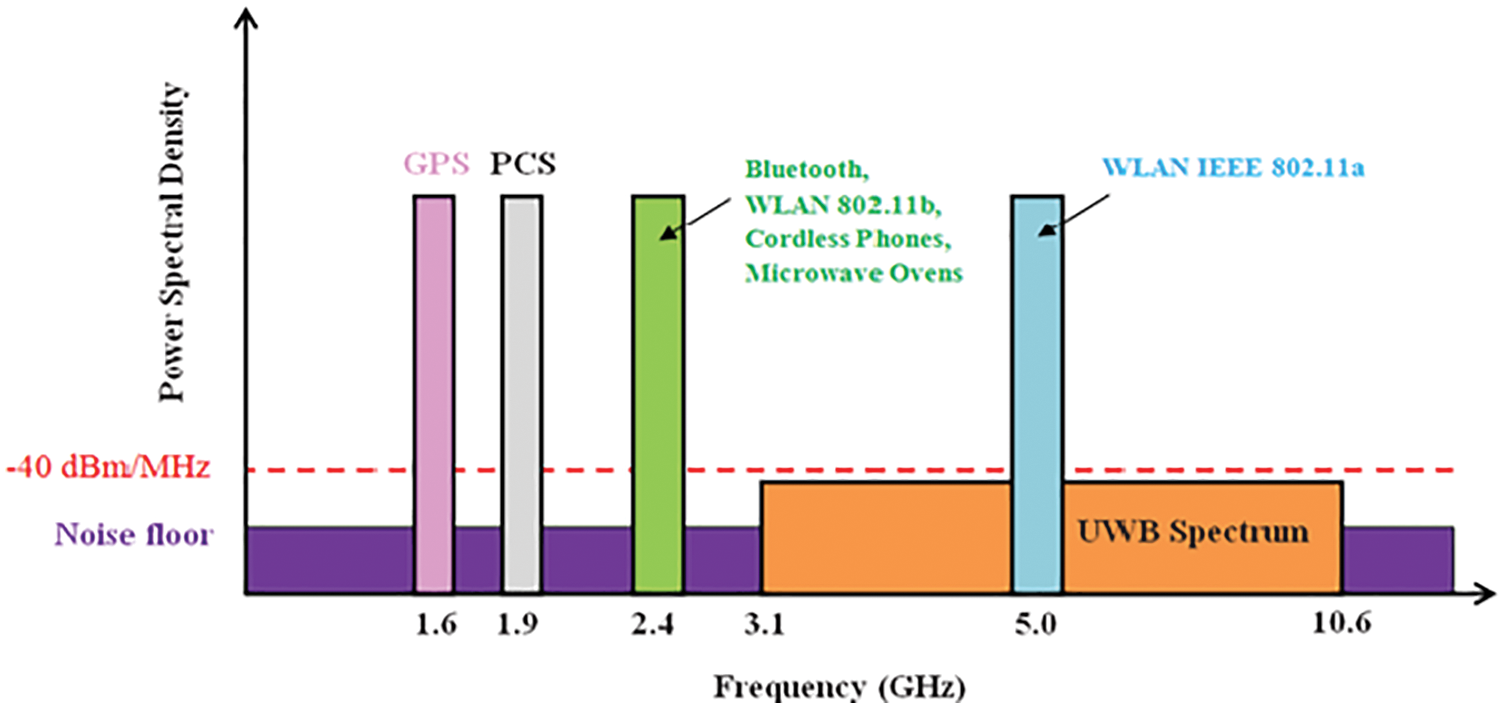
Figure 1: Some Operating frequencies of UWB and narrowband [3]
By merging the communication system with the textile technology approach, the UWB antenna with garment materials has been used for wearable applications and is fabricated and presented in this paper. By delivering wearable tracking and monitoring-based applications, the concept of such a system has improved the quality of life of humans. The reliability of the wireless communication connection between body-worn electronics and the surrounding environment is ensured through wearable tracking and monitoring. Moreover, wearable antennas have some advantages, such as being comfortable, high flexible, washable, and lightweight [4–6]. Furthermore, the UWB antenna provides low-power operation and low radiated power, making it an appealing option for body-worn battery-operated devices with low/medium data rates.
Recently, many wearable UWB antenna has been developed and established. In [7], the authors have shown the development of textile antenna on denim jeans material which successfully achieve Industrial, Scientific and Medical (ISM) Band at 2.45 and 5.8 GHz. The study on the human tissue has been carried out by considering the skin, fat, and muscle that resulted in the gain and bandwidth performances. The author in [8] managed to cater to wireless local area network (WLAN) and UWB applications by designing a dual band textile antenna defined with an artificial magnetic conductor (AMC) plane that achieved an impedance bandwidth of 410 and 540 MHz. 3 × 3 array AMC cell structure integration is tested on the body at 10 and 20 mm distances. Such antenna is fabricated on the Shieldit Superconductive textile from LessEMF Inc. The material selection and fabrication process play a critical role in implementing such antennas. Furthermore, additional tuning processes and measurement setup are required to sign the functional design with optimum performance of flexible antennas [9–12].
The proposed wearable antenna has been successfully performed at the UWB band from 3.1 to 10.6 GHz. The provided antenna is square in shape, with a 60 × 60 mm2 substrate and a partial ground plane structure. The reflection coefficient, radiation pattern, and high efficiency of more than 88 percent of the coaxial feed antenna have been evaluated in modeling and measurement mode. Furthermore, bending angles of 2°, 4°, 6°, 8°, and 10° were investigated. The greatest difficulty emerges during the fabrication process because such an antenna is prone to wrinkling and could result in an air gap between the Shieldit super and the textile. Furthermore, the proposed wearable antenna’s wet performance has been investigated in four states of fully wet: instantly wet, approximately dry, and entirely dry.
The following is a summary of the paper’s structure: The antenna structure, experimental setup, and state-of-the-art review are covered in Section 2. The performance study and analysis on the reflection coefficient, wet, bending issue, and tumor experiment are presented in Section 3. All the conclusion is carried out in Section 4.
2 Antenna Design and Configuration
The main innovation in this investigation is utilizing the conductive garment known as electro-textile, which enables flexibility, lightweight, comfort, and low electrical losses. Therefore, rather than employing hard circuit boards, felt is employed as a substrate, and Shieldit Super is used as a ground plane.
The selection of suitable substrate and conducting materials for the textile antenna with optimum performance really matters. There are many substrate materials such as woven fiberglass, fleece fabric, flannel, cotton, denim, Hypalon, and jeans fabric with specific permittivity, thickness, and performance characteristics, as shown in Tab. 1. Conducting materials such as a Shieldit super, Nora dell, silver platted nylon, copper conducting sheet, woven copper thread, and Shieldit conducting fabric are the most selected materials in research. Shieldit Super has been chosen as the conducting material among all the conducting material in this research. It has a promising high conductivity that will help the gain increment and is the primary choice for this research.

The UWB antenna was designed using the microstrip patch antenna’s optimal rectangular shape. This antenna operates at a resonant frequency under a tolerable reflection coefficient, S11 of less than -10 dB. In this design, a truncated technique with a partial ground inserted current using coaxial probe feed is introduced to achieve better performance of the proposed antenna. As shown in Fig. 2, the antenna’s substrate size is 60 mm square with the patch width and length of 30 mm square. While the feedline has a 35 mm length and a width of λ/2 is 6 mm. The SMA has been attached to the antenna’s coaxial feed line at the microstrip line’s bottom terminal. Further research has been carried out by building an antenna with a partial ground plane that is capable of working at ultra-wideband frequencies. The geometry of the antenna structure is depicted in Fig. 2. The prototype of the proposed UWB antenna is fabricated, as shown in Fig. 3.
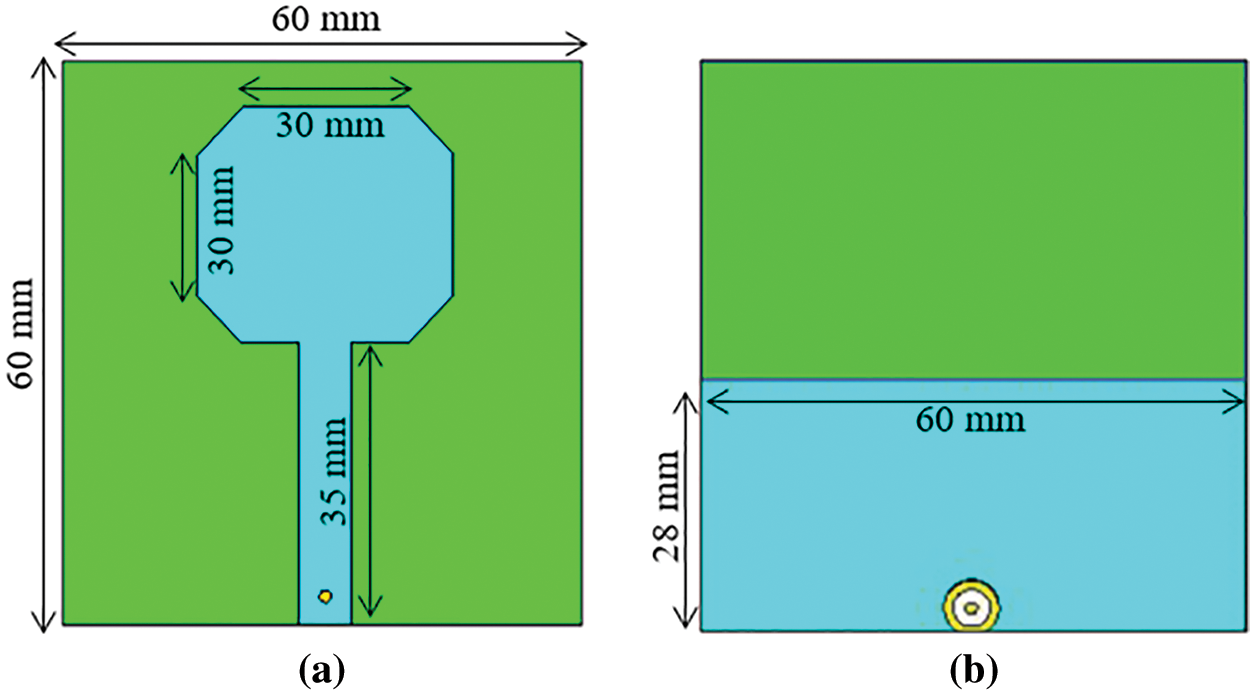
Figure 2: The simulated antenna (a) front and (b) rear view of the antenna
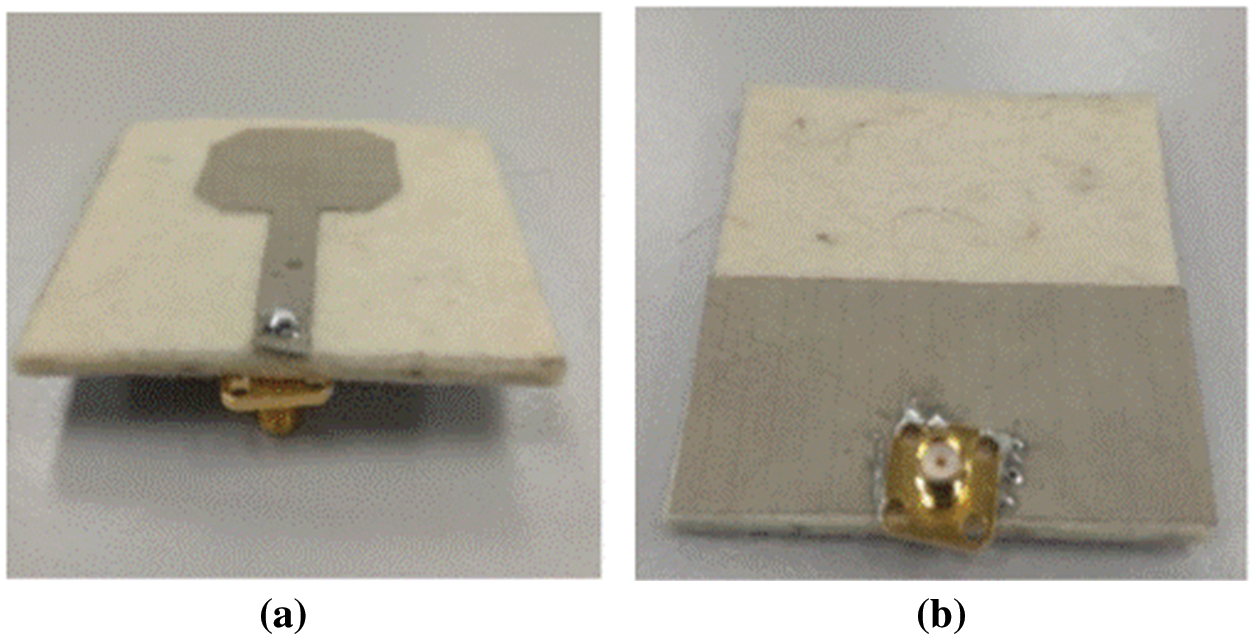
Figure 3: The fabricated antenna (a) front and (b) rear view
There are two types of different breast phantoms which are homogeneous and heterogeneous [13–15]. A basic breast phantom with simple skin and fatty tissue is known as a homogenous breast phantom. Skin, adipose tissue, and glandular tissue make up the heterogeneous breast. Petroleum jelly, a combination of water, flour, and soy oil, were used to make a heterogeneous breast phantom [10]. The measurement for making breast phantom is 100 g of petroleum jelly, 50 g of soy oil, and 37 g of wheat flour. Homogenous phantom is just made from petroleum jelly only. Lastly, the tumor is developed using a mixture of 6 g of water and 12 g of flour. Fig. 4a shows the ingredients needed to do breast phantom. Fig. 4b depicts the mixture of petroleum jelly, oil, and wheat flour. Fig. 4c shows the sample of phantom inside the glass that resembles human skin. Lastly, Fig. 4d shows the tumor sample, which is made from flour and water. The tumor will be placed inside the phantom in the designated area and will be measured. The reason for choosing the glass is that it has good dielectric properties with an optimum performance similar to human skin.
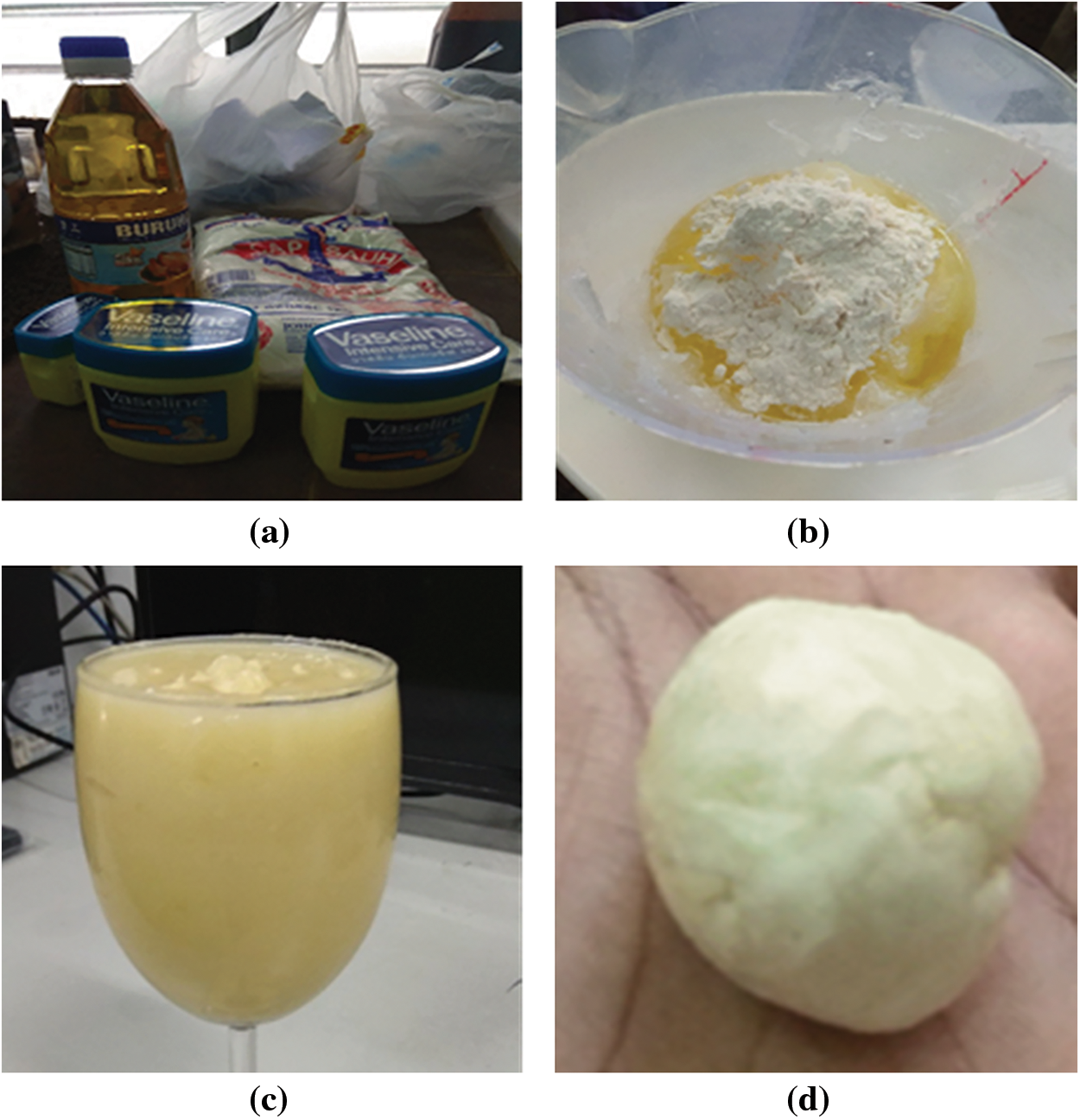
Figure 4: The phantom setup. (a) all ingredients, (b) ingredient batter, (c) breast phantom, and (d) sample of the tumor
This section presents the antenna’s reflection coefficient as measured using a network analyzer in free space only. The experimental setup is performed using a Programmable Network Analyzer (PNA) in the Faculty of Electronic Engineering Technology, Universiti Malaysia Perlis to validate the performance. Finally, the fabricated antenna has been measured and compared with simulated results.
3.1 Analysis of Wearable UWB Antenna
Fig. 5 shows the comparison of simulated and measured results. The measurement result shows a slight decrement, especially at the high frequency, due to the fabrication tolerance and soldering effect. However, the simulation results achieve a wide bandwidth achievement from 3 to 10.6 GHz under a tolerable reflection coefficient of −10 dB, indicating 90% power transmission and 10% reflection power. Tab. 2 summarizes the comparison of gain and efficiency measurement results on various frequencies between 3 and 9 GHz. On average, the antenna achieves more than 65% efficiency throughout the operation band, with 5 GHz showing the lowest value.

Figure 5: The simulated and measured reflection coefficient

Moreover, 4.5 dBi is the maximum achieved gain at 9 GHz. Fig. 6 illustrates the simulated 2D radiation pattern at several frequencies of 3, 4, 5 and 6 GHz. The pattern indicates that the energy is transmitted in an omnidirectional shape.

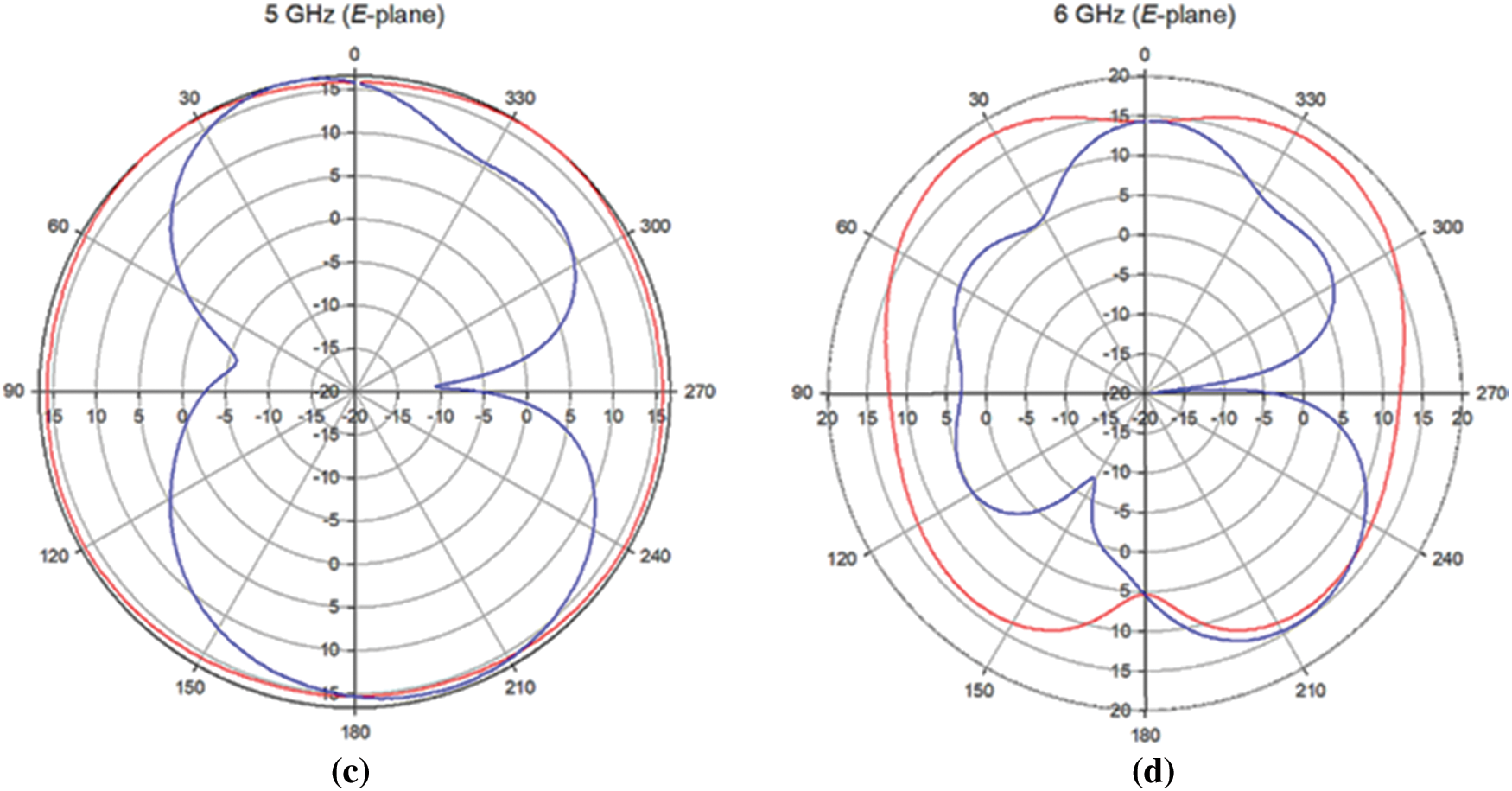
Figure 6: Simulated results of 2D radiation
3.2 Analysis of UWB Antenna on Bending Conditions
Different bending condition is executed to investigate the antenna’s performance ability and user-friendly effectiveness. There are five main focused bending angles which are at 2°,4°,6°,8°, and 10°. Fig. 7 shows the bending condition with calculated radius and determines focus angle using Eqs. (1) and (2). The bending of 2° gives a radius of 1714.2 mm, while the 10° gives a radius of 342.8 mm.

Figure 7: Bending condition of the presented UWB antenna
Fig. 8 shows the measured results of the bending condition for all focus bending angles. The Agilent Technologies E83628 PNA operated from 100 MHz to 20 GHz has captured a reflection coefficient, S11 results, and plotted between targeted frequency ranges 2 to 10 GHz. The measured results indicate some variations that 4˚, 6˚, and 8˚ bending angles have achieved a wide bandwidth (with more than 7 GHz that meets FCC requirement under tolerable reflection coefficient, S11 < 10 dB) as compared with the 10˚ bending. In contrast, a 10° angle has lesser impedance bandwidth. Tab. 3 shows the developed antenna’s simulated gain, radiation, and total efficiency at 6.5 GHz. It shows that the gain incline with the proportional frequency, which abide by the theoretical study. Moreover, the presented antenna has more than 80% efficiency for all bending angles conditions with a maximum gain of 3.74 dBi at
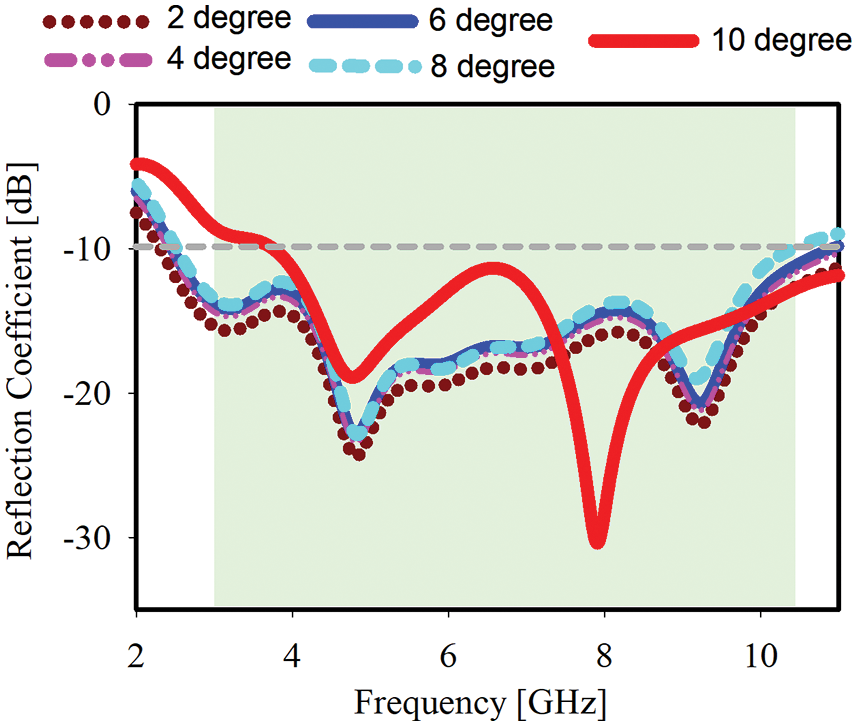
Figure 8: Measured UWB antenna on bending conditions

whereas r is the radius, S represents the arc length, and
3.3 Wet-Conditions Analysis of a UWB Antenna
These investigations cover four sorts of wet conditions: totally dried, partially dried, partially wet, and fully wet. The relevant environment, as indicated in Fig. 9, is the basis for all four different circumstances. Each circumstance has its own unique characteristics, such as fully wet and partially wet, which relates to the antenna in a rainy or spray environment. Meanwhile, the term “roughly dried” refers to the antenna’s condition after being exposed to sweat from the human body. Finally, after it has had no direct touch with any moisture, it is deemed completely dry.
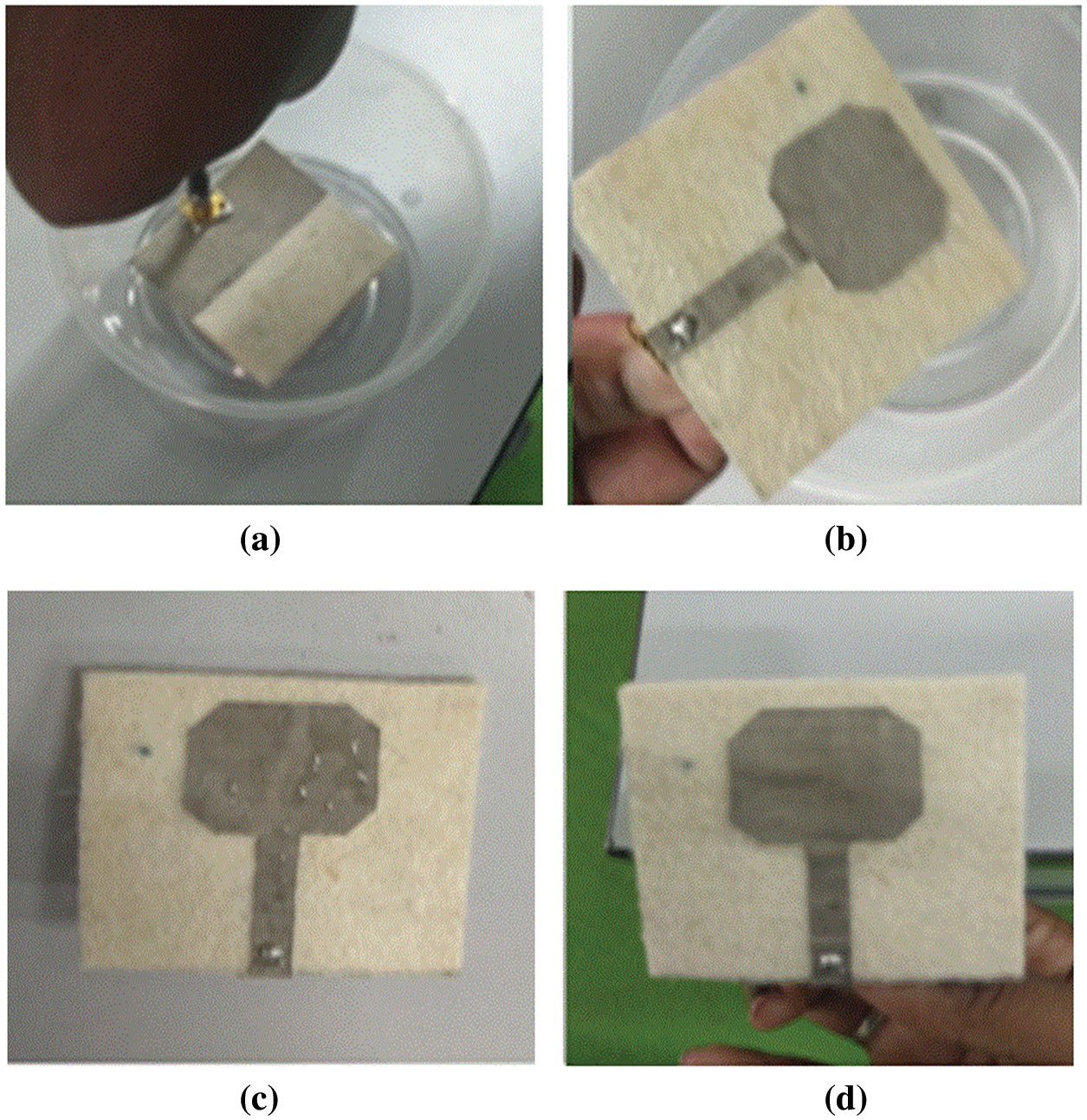
Figure 9: The four types of wet conditions. (a) Fully wet, (b) Partially wet, (c) Partially dried, (d) Totally dried
Fig. 10 demonstrates the S11 reflection coefficient results of textile UWB antenna on these four wet conditions from 2 to 9 GHz operating frequency. Partially dried and fully wet conditions offer the dual impedance bandwidth with reflecting the water exposed. At the same time, the partially dried indicates better bandwidth (BW) result, which is more than 5.5 GHz BW as regulated by FCC with an introduction of band notch at approximately 5 GHz resonant. Moreover, the dried achieved 4.5 GHz bandwidth with an average S11 impedance matching of less than −10 dB throughout the measured frequency.
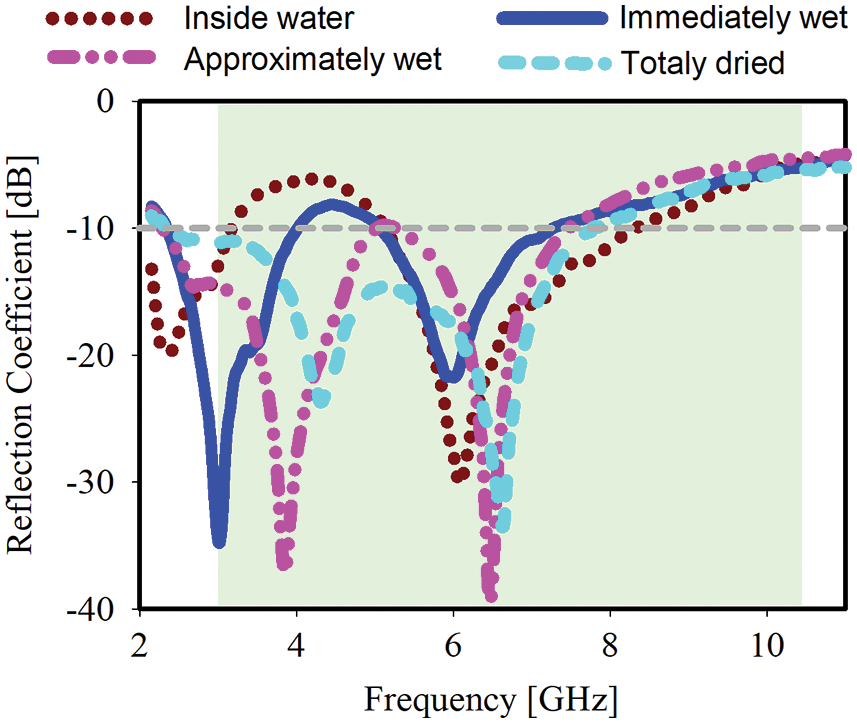
Figure 10: The measured S11 performance in various wet conditions
3.4 Breast Phantom with and without Tumor
In this study, two different breast conditions have been studied: healthy breast and breast with a tumor. The measurement setup is illustrated in Fig. 11. Measurement of the healthy breast is done using a breast phantom that develops in the house while the result is being compared to the phantom breast with a tumour of the size of 2 mm. Fig. 12 shows the reflection coefficient result of the healthy breast and breast with a tumour in the frequency range of 2 to 11 GHz. The reflection coefficient is much lower in the presence of the tumor, as can be shown. From the result, a significant difference in the S11 pattern where the frequency is shifted resulted in the reaction of the tumor existence. The tumor phantom results in lower decreases than normal, especially between 4 and 7 GHz.
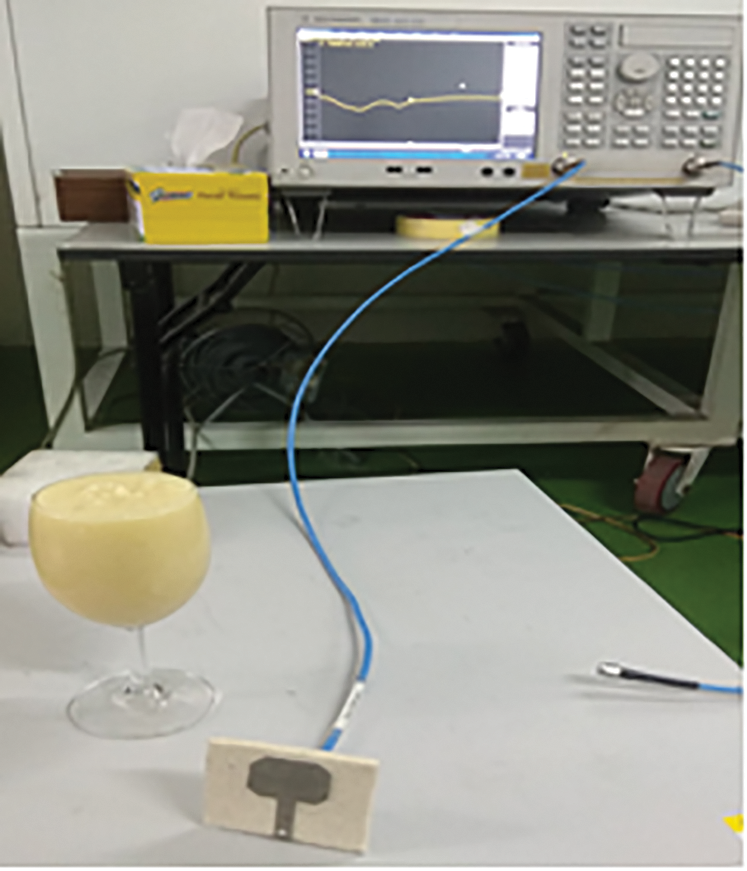
Figure 11: The measurement condition of the antenna together with phantom
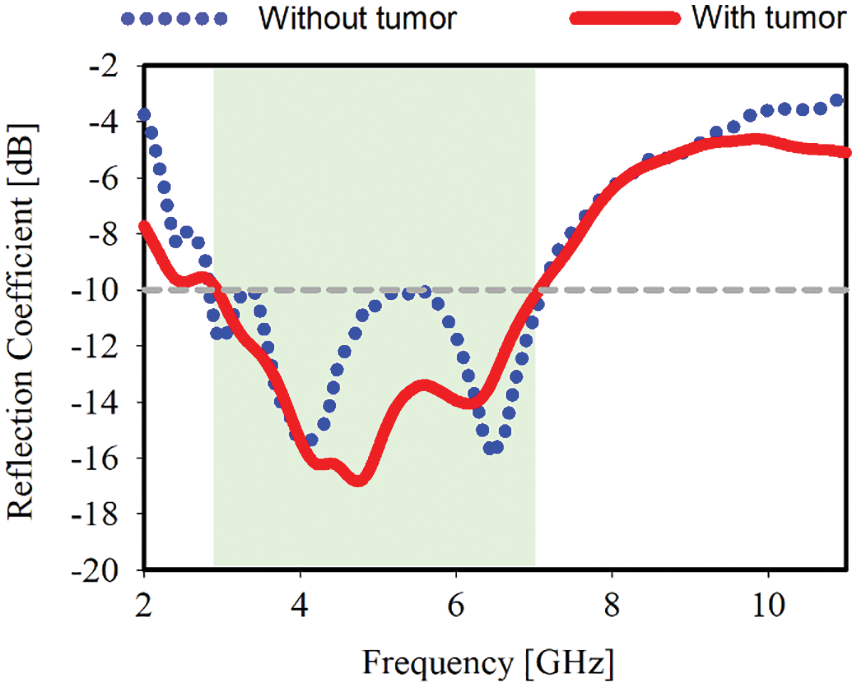
Figure 12: Measured reflection coefficient result of with and without Tumor
The primary aim of the research is to develop an efficient, lightweight, and low-cost ultra-wideband antenna capable of operating in the UWB frequency band. The best conductive textile chosen in this investigation is Shieldit Super, with adhesive reverse sides that enable it to be secured firmly onto the antenna substrate. Flexible and low permittivity foam is used as a substrate in the design, which facilitates enhancement, avoids the generation of surface waves, and enables conformity to the human body. Therefore, the simple antenna structure with a hexagon radiating element has been developed with a compact size of 60 mm square. The bending studies at a few variances of 2 to 10 are carried out, and the analysis is focused on the gain and radiation efficiency. The suggested antenna is functioned to detect an existing tumor, which is capable of early detection of breast cancer. Moreover, upcoming research will be foreseen to be focused on the realization of the proposed UWB antenna system in future synthetic microwave imaging applications as in [16] based on the performance analysis and collecting data of the received signal.
Funding Statement: The authors received no specific funding for this study.
Conflicts of Interest: The authors declare that they have no conflicts of interest to report regarding the present study.
References
1. F. Foroutan and N. K. Nikolova, “UWB active antenna for microwave breast imaging sensing arrays,” IEEE Antennas Wireless Propagation Letter, vol. 18, no. 10, pp. 1951–1955, 2019. [Google Scholar]
2. S. S. Al-Bawri, H. G. Hwang, M. S. Islam, H. Y. Wong, M. F. Jamlos et al., “Compact ultra-wideband monopole antenna loaded with metamaterial,” Sensors, vol. 20, no. 3, pp. 796, 2020. [Google Scholar]
3. M. S. Shakhirul, M. Jusoh, A. Sahadah, C. M. Nor and H. A. Rahim, “Embroidered wearable textile antenna on bending and wet performances for UWB reception,” Microwave Optical Technology Letter, vol. 56, no. 9, pp. 2158–2163, 2014. [Google Scholar]
4. A. Yadav, V. K. Singh, A. K. Bhoi, G. Marques, B. Garcia-Zapirain et al., “Wireless body area networks: UWB wearable textile antenna for telemedicine and mobile health systems,” Micromachines, vol. 11, no. 558, pp. 1–22, 2020. [Google Scholar]
5. K. Hossain, T. Sabapathy, M. Jusoh, P. J. Soh, S. S. Al-Bawri et al., “Decagonal c-shaped CSRR textile-based metamaterial for microwave applications,” Computers, Materials and Continua, vol. 71, no. 1, pp. 1677–1693, 2022. [Google Scholar]
6. K. Hossain, T. Sabapathy, M. Jusoh, P. J. Soh, M. N. Osman et al., “A compact wideband CSRR near zero refractive index and epsilon negative metamaterial for wearable microwave applications,” Journal of Physics: Conference Series, vol. 1962, no. 1, pp. 1–8, 2021. [Google Scholar]
7. K. H. Wang and J. S. Li, “Jeans textile antenna for smart wearable antenna,” in 12th Int. Symp. on Antennas, Propagation and EM Theory, ISAPE, Hangzhou, China, pp. 1–3, 2018. [Google Scholar]
8. N. F. Mohd Aun, J. P. Soh, A. A. Al-Hadi and H. Lago, “Dual band textile monopole antenna with AMC plane for WLAN and UWB applications,” in IEEE Asia-Pacific Conf. on Applied Electromagnetics (APACE), Melacca, Malaysia, pp. 1–4, 2019. [Google Scholar]
9. M. E. Jalil, M. K. Rahim, M. A. Abdullah and O. Ayop, “Compact CPW-fed ultra-wideband (UWB) antenna using denim textile material,” in Int. Symp. on Antennas and Propagation (ISAP), Nagoya, Japan, pp. 30–33, 2012. [Google Scholar]
10. K. Hossain, T. Sabapathy, M. Jusoh, P. J. Soh, M. H. Jamaluddin et al., “Electrically tunable left-handed textile metamaterial for microwave applications,” Materials, vol. 14, pp. 1274, 2021. [Google Scholar]
11. K. Hossain, T. Sabapathy, M. Jusoh, M. A. Abdelghany, P. J. Soh et al., “A negative index nonagonal CSRR metamaterial-based compact flexible planar monopole antenna for ultrawideband applications using viscose-wool felt,” Polymers, vol. 13, no. 16, pp. 2819, 2021. [Google Scholar]
12. A. D. Natale and E. D. Giampaolo, “UWB reversible structure all-textile antenna for wireless body area networks applications,” PhotonIcs & Electromagnetics Research Symp. - Spring (PIERS-Spring), Rome, Italy, pp. 566–569, 2019. [Google Scholar]
13. E. Porter, J. Fakhoury, R. Oprisor, M. Coates and M. Popovic, “Improved tissue phantoms for experimental validation of microwave breast cancer detection,” in Proc. of the Fourth European Conf. on Antennas and Propagation (EuCAP), Barcelona, Spain, pp. 1037–1040, 2010. [Google Scholar]
14. M. Lazebnik, D. Popovic, L. Mccartney, L. Watkins, C. B. Lindstrom et al., “A large-scale study of the ultrawideband microwave dielectric properties of normal, benign and malignant breast tissues obtained from cancer surgeries,” Physics in Medicine & Biology, vol. 52, no. 20, pp. 6093–6115, 2007. [Google Scholar]
15. S. A. Alshehri and S. Khatun, “UWB imaging for breast cancer detection using neural network,” Progress In Electromagnetics Research C, vol. 7, pp. 79–93, 2009. [Google Scholar]
16. S. S. Al-Bawri, M. T. Islam, M. J. Singh and M. T. Islam, “Compact wideband five-port reflectometer based on symmetrical waveguide ring junction for synthetic microwave imaging applications,” International Journal of Communication Systems, vol. 35, no. 3, pp. e5032, 2022. [Google Scholar]
 | This work is licensed under a Creative Commons Attribution 4.0 International License, which permits unrestricted use, distribution, and reproduction in any medium, provided the original work is properly cited. |